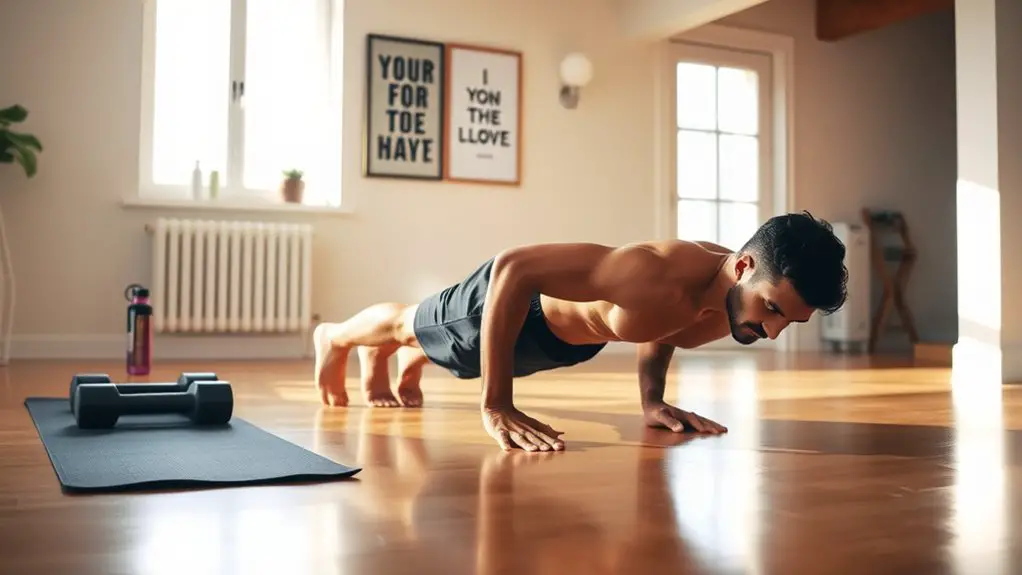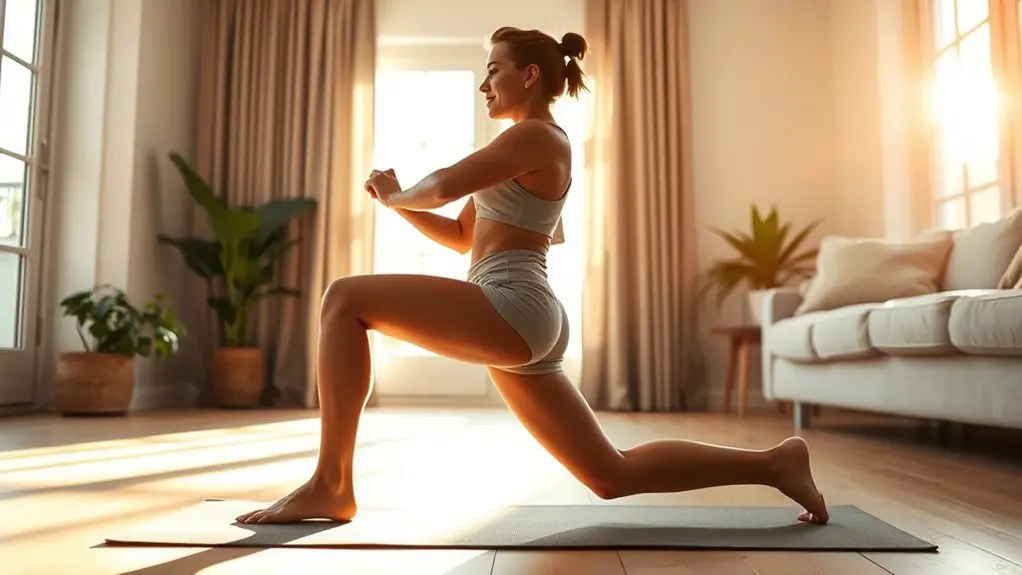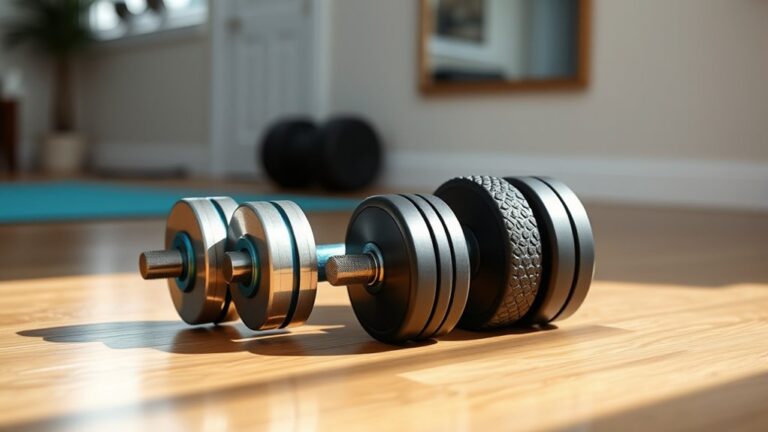The Best Bodyweight Exercises for Strength Training at Home

If you’re looking to build strength at home, bodyweight exercises are a fantastic option. Try push-ups for your upper body, squats for your legs, and planks for core stability. Lunges enhance your leg power, while glute bridges target your posterior chain. Dips can sculpt your arms, and burpees provide a full-body workout. Incorporating these exercises into your routine can lead to impressive gains. You’ll discover even more effective techniques ahead.
Push-Ups: The Classic Upper Body Builder

Push-ups are a timeless exercise that can transform your upper body strength. They engage multiple muscle groups, including your chest, shoulders, and triceps, making them incredibly effective. To keep your routine fresh and challenge yourself, try different push-up variations, like incline or decline push-ups, which target muscles from various angles.
The push-up benefits extend beyond muscle building; they also enhance core stability and improve overall endurance. By maintaining proper form, you’ll minimize the risk of injury and maximize your gains. Start with a few repetitions and gradually increase as you become more comfortable.
Don’t forget to listen to your body; if you feel pain, it’s essential to stop and reassess your technique. By incorporating push-ups into your home workout regimen, you’re not just working out; you’re building a stronger, healthier you while staying safe.
Squats: Strengthening Your Lower Body
Squats are a fundamental exercise for building strength in your lower body, and there are plenty of variations to keep things interesting. Understanding the proper squat form is essential to maximize your results and prevent injury. Let’s explore different squat types and how to perform them correctly.
Squat Variations Explained
When it comes to building lower body strength, mastering squat variations can make a significant difference in your workout routine. Start with bodyweight squats, focusing on squat depth and ensuring you lower your hips below your knees for maximum effectiveness. As you progress, try variations like sumo squats or single-leg squats to target different muscle groups while enhancing stability. Don’t forget about squat tempo—slowing down your descent can increase time under tension, leading to better strength gains. Always listen to your body and maintain proper alignment to avoid injury. Incorporating these squat variations into your routine can keep your workouts fresh and engaging, helping you achieve your strength goals safely and effectively.
Proper Squat Form
To effectively strengthen your lower body, mastering proper squat form is essential. Begin by standing with your feet shoulder-width apart, keeping your toes slightly outward. As you lower into the squat, make certain your knees track over your toes, avoiding any inward collapse. Focus on achieving a comfortable squat depth, ideally lowering until your thighs are parallel to the ground. This position maximizes muscle engagement while minimizing injury risk. Incorporate squat variations, like sumo or jump squats, to keep your routine dynamic. Remember to engage your core and maintain a straight back throughout the movement. By prioritizing proper form, you’ll build strength effectively and safely, leading to better performance in all your bodyweight exercises.
Planks: Core Stability and Strength

Planks are a fantastic way to build core stability and strength, and there are plenty of variations to keep things interesting. To get the most out of your planks, it’s essential to maintain proper form and avoid some common mistakes. Let’s explore how you can master this exercise and maximize its benefits.
Benefits of Plank Variations
Although you might think of planks as simple static holds, their variations offer a wealth of benefits that enhance core stability and strength. By incorporating plank variations into your routine, you can improve core engagement, making your workouts more effective. These exercises challenge different muscle groups, helping to build balanced strength throughout your body. Variations like side planks and plank jacks not only engage your core but also enhance your shoulder and hip stability. Plus, they keep your workouts interesting and prevent plateaus. Just remember to listen to your body and choose variations that suit your fitness level to guarantee safety and effectiveness. With consistent practice, you’ll notice significant improvements in your overall strength and stability.
Proper Plank Form
Mastering proper plank form is essential for maximizing the effectiveness of this foundational exercise. Start by positioning your forearms on the ground, elbows directly beneath your shoulders. Your body should form a straight line from head to heels. Engage your core for stability; this core activation is key to preventing lower back strain. Keep your hips level—don’t let them sag or rise too high. You can explore plank variations, like side planks or plank jacks, but always prioritize form over duration or complexity. Verify your neck is neutral, gazing down at the ground to avoid strain. By maintaining proper alignment, you’ll build strength safely and effectively, laying the groundwork for more advanced exercises in your routine.
Common Mistakes to Avoid
When you’re diving into planks, it’s easy to fall into some common traps that can undermine your core stability and strength. One major mistake is allowing your hips to sag or rise too high, which can lead to form errors and strain your lower back. Always keep your body in a straight line from head to heels. If you’re struggling to maintain this position, don’t hesitate to use exercise modifications, like dropping to your knees, to help build strength safely. Additionally, avoid holding your breath; focus on steady, controlled breathing to support your core. By correcting these form errors and making appropriate modifications, you’ll enhance your plank effectiveness and reduce the risk of injury.
Lunges: Enhancing Leg Power and Balance

Lunges are a fantastic exercise for boosting leg power and improving balance, making them a staple in any at-home strength training routine. When performing lunges, focus on maintaining proper form to guarantee safety and maximize benefits. Start by standing tall, step forward with one leg, and lower your hips until both knees are bent at roughly a 90-degree angle. Keep your front knee aligned over your ankle to prevent strain.
Incorporate lunges into your balance training by adding variations like reverse lunges or side lunges. These variations not only target different muscle groups but also enhance coordination and stability. Remember to engage your core throughout the movement to support your spine and improve leg strength.
As you progress, you can increase the number of repetitions or add weights. Always listen to your body, and if you feel any discomfort, take a break or adjust your technique.
Glute Bridges: Targeting the Posterior Chain
Building on the foundation of leg strength and balance developed through lunges, glute bridges are an excellent addition to your home workout routine. This exercise effectively targets the posterior chain, helping to strengthen your glutes, hamstrings, and lower back. To perform a glute bridge safely, lie on your back with your knees bent and feet flat on the floor, hip-width apart. As you lift your hips towards the ceiling, focus on glute activation, squeezing your glutes at the top of the movement.
Hold for a moment before lowering back down, making sure you maintain a neutral spine throughout. This controlled motion not only builds strength but also enhances stability, which is vital for preventing injuries. Aim to include glute bridges in your workouts two to three times a week for best results. Remember to listen to your body and adjust the intensity as needed to guarantee proper form and safety.
Dips: Sculpting the Arms and Shoulders
Dips are one of the most effective exercises you can incorporate into your strength training routine to sculpt your arms and shoulders. By targeting your triceps, shoulders, and chest, you’ll enhance your arm strength and shoulder definition. To safely perform dips at home, keep these tips in mind:
- Use a Stable Surface: Verify your chair or bench can support your weight without wobbling.
- Maintain Proper Form: Lower your body until your elbows are at a 90-degree angle, avoiding excessive shoulder strain.
- Control Your Movement: Focus on a slow, controlled descent and ascent to engage your muscles effectively and prevent injury.
Incorporating dips into your workout not only builds strength but also enhances muscle tone. Just remember to listen to your body and adjust the intensity as needed to keep your training safe and effective. Additionally, consider including alternative exercises that target similar muscle groups to diversify your routine and prevent plateaus.
Burpees: Full-Body Conditioning and Endurance
While you might dread them, burpees are one of the best exercises for full-body conditioning and endurance. They engage almost every muscle group, making them highly effective for building strength and stamina. To perform a burpee safely, start in a standing position, drop into a squat, kick your feet back into a plank, return to the squat, and jump up explosively.
If you’re looking for a challenge, try burpee variations like the tuck jump or push-up burpee to enhance your workout. These variations can help prevent boredom and keep you engaged while reaping the conditioning benefits.
Always listen to your body; if you feel any discomfort, consider modifying the movement or taking breaks as needed. Incorporating burpees into your routine can greatly improve your overall fitness, making you stronger and more agile. Remember, consistency is key, so aim to include them regularly in your home workouts!
Frequently Asked Questions
How Often Should I Do Bodyweight Exercises for Optimal Strength Gains?
To optimize strength gains, you should follow frequency guidelines that recommend working out 2 to 4 times a week. This allows your muscles to recover while still challenging them. Incorporating workout variations keeps things fresh and helps prevent plateaus. Remember, listen to your body; if you feel fatigued or sore, it’s okay to take an extra rest day. Prioritizing safety will guarantee you stay healthy and make consistent progress.
Can Bodyweight Exercises Build Muscle Like Weights?
Absolutely, bodyweight exercises can work wonders for muscle hypertrophy, just like weights. They offer a safe way to build strength while keeping things interesting with exercise variation. By incorporating different movements and adjusting intensity, you can effectively challenge your muscles. Just remember, consistency is key! You’ll want to push your limits gradually, ensuring your body adapts safely. So, embrace those push-ups and squats; they’re more powerful than you might think!
What Is the Best Warm-Up Before Starting Bodyweight Workouts?
Before starting your bodyweight workouts, it’s essential to warm up properly to prevent injuries. You should focus on dynamic stretching and mobility drills. Try leg swings, arm circles, and torso twists to loosen up your muscles and joints. These exercises increase blood flow and enhance your range of motion. Remember, a good warm-up not only prepares your body but also improves your overall performance during the workout, so don’t skip it!
How Can I Track My Progress With Bodyweight Exercises?
Ah, the pursuit of progress! To track your progress with bodyweight exercises, consider keeping a progress journal or using workout apps. Document your reps, sets, and any variations you try. This not only helps you see improvements over time but also guarantees you’re maintaining proper form and safety. Regularly reviewing your entries will keep you motivated and allow you to adjust your routine as needed. Remember, consistency is key to achieving your fitness goals!
Are Bodyweight Exercises Safe for Beginners?
Yes, bodyweight exercises are generally safe for beginners. To guarantee your beginner safety, start with simple movements and focus on proper form. It’s also wise to incorporate exercise modifications if a particular move feels too challenging. By adjusting the intensity and complexity, you can gradually build your strength while minimizing the risk of injury. Always listen to your body, and don’t hesitate to take breaks when needed. Your safety should always come first!





